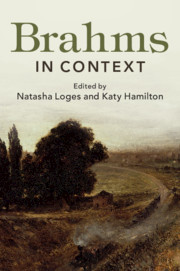Book contents
- Brahms in Context
- Brahms in Context
- Copyright page
- Dedication
- Contents
- Illustrations
- Music Examples
- Notes on Contributors
- Preface
- Abbreviations
- Part I Personality, People and Places
- Part II Identities, Environments and Influences
- Part III Performance and Publishing
- Part IV Society and Culture
- Part V Reception and Legacy
- Further Reading
- Index
- References
Part I - Personality, People and Places
Published online by Cambridge University Press: 15 May 2019
- Brahms in Context
- Brahms in Context
- Copyright page
- Dedication
- Contents
- Illustrations
- Music Examples
- Notes on Contributors
- Preface
- Abbreviations
- Part I Personality, People and Places
- Part II Identities, Environments and Influences
- Part III Performance and Publishing
- Part IV Society and Culture
- Part V Reception and Legacy
- Further Reading
- Index
- References
Summary
‘Today, my dear wife, née Nissen, successfully delivered a healthy boy. 7th May 1833. J. J. Brahms.’ Thus, on 8 May 1833Johann Jakob Brahms announced the birth of his first son Johannes in the local paper, the Privileged Weekly General News of and for Hamburg (Privilegirte wöchentliche gemeinnützige Nachrichten von und für Hamburg). At a time when such announcements were the exception, this was a clear sign of pride. Johann Jakob Brahms or Brahmst, as he also spelled it, was born on 1 June 1806 in Heide in Holstein, the second son of the innkeeper and trader Johann Brahms, who had moved to Heide from Brunsbüttel via Meldorf. His ancestors were from Lower Saxony. Johann Jakob completed a five-year apprenticeship as a city wait in Heide and Wesselburen, during which he learned the flugelhorn, flute, violin, viola and cello, then standard instruments. In early 1826, the young journeyman began his travels with his certificate of apprenticeship, received in December 1825.
Keywords
- Type
- Chapter
- Information
- Brahms in Context , pp. 1 - 68Publisher: Cambridge University PressPrint publication year: 2019



